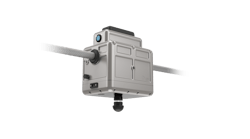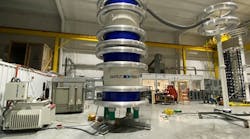More than 25 companies have joined a research program sponsored by Doble Engineering to investigate the problem of corrosive sulfur. The study is moving along quickly, according to Doble, but the company is still accepting new members into the collaboration.
The members include transformer oil refiners, apparatus manufacturers, utilities, and an insurance company. This is an industry problem that needs to be resolved through improved specifications, a better understanding of the corrosion process, and methods for detection and mitigation, according to Doble.
Although copper sulfide cannot be removed there are methods that might greatly reduce further formation of conductive metal-sulfur compounds in problem units. Doble says that researching this problem as a group, representing a cross-section of the industry, provides substance and can help accelerate changes required to detect and mitigate this problem.
The problem of corrosive sulfur has reappeared after not being a significant issue for decades. In the past few years there have been a number of failures of large power transformers and shunt reactors due to corrosive sulfur. This has occurred even though the electrical insulating mineral oils passed international standard test methods including ASTM D 1275 and DIN 51353.
The problem occurs because the corrosive sulfur reacts with copper conductors and silver contacts to form metal sulfides that contaminate the insulating paper. Since metal sulfides are conductive, the dielectric breakdown strength of the paper is reduced. Under some conditions, a breakdown occurs through the insulation between conductor strands on a disk or between disks. The photo shows the evidence of discharge activity on the paper-wrapped conductor strands facing the center axis of this four year old transformer winding. This discharge activity ultimately leads to apparatus failure. Although the number of failures has been small, the value of assets lost have been substantial. Problems have been reported from many countries.
Doble says that transformers with oils that do not meet the Doble-modified corrosive sulfur tests are more susceptible to this problem. The most recent revision of the Doble Transformer Oil Purchase Specification includes important details. The problem with corrosive sulfur is both time- and temperature-dependent. The longer an apparatus operates at higher temperatures with an oil containing excessive amounts of corrosive sulfur, the greater the corrosion and formation of metal sulfides. Sealed transformers are more susceptible to the corrosive sulfur problem as oxygen reacts with copper and organo-metallic compounds which compete for reaction sites with the corrosive sulfur. This slows down the formation of the conductive metal sulfides but does not stop their formation. Lower voltage apparatus have can have an advantage if the copper conductors are coated with enamel insulation. The enamel creates a barrier preventing reaction with the corrosive sulfur. The various factors that can influence copper sulfide formation will be investigated in the collaborative study.
Standards organizations need to revise present specifications for a more rigorous evaluation for corrosive sulfur. Doble has revised its insulating mineral oil specification requirements for corrosive sulfur by modifying the present ASTM method D 1275. The modifications include extending the duration of the test from 19 to 48 hours and increasing the test temperature from 140ºC to 150ºC. Some added precautions are taken to minimize the oxygen content in the test oil. In testing to date, Doble has found that the oils from failed transformers with evidence of copper sulfide formation did not pass this modified test, but did pass the present ASTM method. As additional research is performed it is likely that new methods will be developed. Part of the collaborative study is to evaluate test methods for detecting the corrosive sulfur.
All failures have occurred without prior evidence of an incipient fault. This makes the problem difficult to detect and manage. The failures have occurred after from one to several years of apparatus being in service. The corrosion process appears to take this time to form critical amounts of conductive sulfides. Dissolved gas-in-oil tests are routinely used to detect developing problems from overheating, partial discharge activity, or arcing. To date dissolved gas-in-oil has not given any indication of partial discharge activity or arcing in these units, even when a sample was taken one day before the failure. Although there can be an in increase in the insulation power factor, this test has not been found to routinely detect this problem when performed in the standard fashion. Some laboratory investigations using power factor have been shown to detect copper sulfide in paper under some conditions. More research is needed to determine if this can be applied to apparatus in the field. As part of the collaborative study electrical tests will be evaluated to see which might be able to detect significant contamination of the cellulosic insulation.
Doble has found that it is likely that there is a substantial amount of oil in service in large power transformers that can cause the sulfur corrosion problems. Although these oils with excessive amounts of corrosive sulfur represent a small percentage of the total oil volume in service, it is still important because copper corrosion and sulfide formation cannot be reversed. It is possible to mitigate against further significant corrosion. Possible methods include removal of the corrosive sulfur compounds, oil replacement, partial oil replacement, and passivation using metal deactivators. No simple means for removing corrosive sulfur compounds from the oil has been developed. Depending on the size of the problem this may be an area for future research.
Preliminary studies at the Doble Laboratory have shown that mineral oils can have considerable differences in the temperatures at which they will begin to form copper sulfide under test conditions. Further studies will be performed. Mixing higher corrosive sulfur content oils with those having low sulfur content can significantly improve the former’s characteristics well beyond acceptable limits.
Another method that has been employed is the use of a passivator that binds up some of the active sites on the metal surface retarding reactions with corrosive sulfur. More research is need and will be performed as part of the collaborative study, to better understand how well these methods will work and the long-term benefits. For the immediate future these methods appear to be promising and could help mitigate developing problems. Some companies have already started using these approaches; and Doble will be monitoring and evaluating the effectiveness as part of its study.



